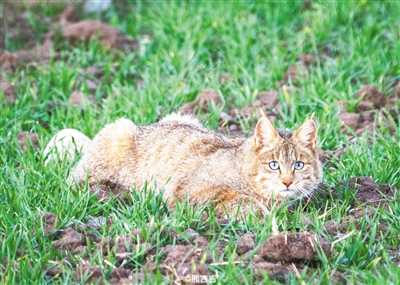Which Uncovers the Mystery of Felis Bieti


Photographed by Xiong Jiji
◆Reporter: Xiao Qi
In the early morning, there is a "hunter" - felis bieti hidden in the rape field just planted in Menyuan. It patiently listens to the surrounding movement and waits for the right time to hunt zokors.
There is the only endemic species felis bieti among 12 species of wild felids living in Qinghai Area of Qilian Mountain National Park. In order to understand the distribution and survival of felis bieti here, the Qinghai Provincial Administration of Qilian Mountain National Park commissioned the School of Life Sciences of Peking University to carry out a special survey of felis bieti from 2019.
In fact, the Qinghai Provincial Administration of Qilian Mountain National Park has performed many special surveys of rare animals such as snow leopards, jackals and black-necked cranes as well as surveys of wild plants and macro fungi since 2017.
How were these special surveys carried out? What are the benefits of the survey results?
Perform surveys via various methods such as field visits, infrared cameras, satellite collars, etc.
Speaking of felis bieti, local herders may wonder what kind of animal is this? But whenever you mention grass cats, everyone will immediately know that it is a wild cat with black circles on its tail, a tuft of short hair on its ears, blue eyes, an appearance like domestic cat and a larger body than domestic cat.
An important way to perform a special survey of wild animals is to grasp the occurrence range of wild animals by asking local residents.
At the end of 2019, the School of Life Sciences of Peking University performed the first round of surveys on felis bieti and searched more than 20 management and protection stations of Qilian Mountain National Park one by one from Menyuan County to Tianjun County.
According to the introduction from Liu Yanlin (Ph.D. of Zoology of Peking University), the residents living there all year round could often see wild animals, and a lot of information could be obtained by talking with them.
In fact, the survey personnel had seen the felis bieti via infrared cameras set up to photograph snow leopards before the special survey of felis bieti. However, the surveys on snow leopard were performed in high-altitude mountains, which did not cover low-altitude areas, and the survey personnel also felt that there were not so many felis bieti at that time and they were mysterious and could not be found easily.
It was not until the survey personnel arrived at the Laohugou Management and Protection Station of Qilian Mountain National Park in Menyuan County that this impression was broken. He Chengwu (a guard in charge of patrol inspection of the management and protection station) took Liu Yanlin to a spruce forest beside the road, and told Liu Yanlin that he had seen the felis bieti here when he once passed by on a motorcycle, which surprised Liu Yanlin very much.
"We began to perform field survey, place infrared cameras at the sites where the felis bieti frequently occurred, and we also tried to put on satellite positioning collars for felis bieti in order to learn more about the living habits of them", Liu Yanlin introduced.
Through a variety of field visits, the survey personnel tried to understand the number of felis bieti and their specific survival crisis, thus, suggestions could be provided for formulating protection schemes.
The results had been obtained after continued surveys finally, and the team initially grasped the distributions of felis bieti. According to the survey, it was found that felis bieti were mainly distributed in the low-altitude shallow mountain areas in the eastern part of Qilian Mountain National Park, including the junction of meadows, shrubs and forest-grass, while the afforestation area of Laohugou was the place where the density of felis bieti is highest.
In addition, the team also had a preliminary understanding of factors that might threaten the survival of felis bieti, such as road killing (collision by road vehicles during the migration), poisoning (eating rodent poison by accident), etc. In this regard, Liu Yanlin suggested that a slowing down warning road sign could be set up beside roads where felis bieti occurred more frequently.
In the next step, the team will continue to assess the degree of influence of domestic cats on the genes of the felis bieti population, and whether it is necessary to strengthen the management of domestic cats in the area or take sterilization measures.
Ecological restoration can provide more living space for felis bieti
According to previous surveys and visits, the survey personnel had set up infrared cameras at lower altitudes, which had captured many rare pictures of felis bieti in May and June. However, the situations became quite different in July, August and September, "it is difficult for us to find felis bieti anymore, everyone guesses that they may move to high altitude areas in summer and wait and will return after the harvest season of highland barley". According to the introduction of Liu Yanlin: "the satellite positioning collar shows that the facts are different. We are still continuing to observe."
The team had a better understanding of the food structure and activity habits of felis bieti through continuous observation. For example, the survey personnel found that the felis bieti mainly hunted voles and zokors at night through the analysis of felis bieti feces and infrared camera data.
Liu Yanlin and the survey personnel felt surprised about the disclosure of the mystery of the felis bieti. felis bieti and human activities are highly overlapped in the Menyuan Basin, and they are closer to humans than snow leopards. There are many artificial forests and farmland in the Menyuan Basin, which is different from the habitat of felis bieti in other areas where there are mainly natural shrubs.
Felis bieti often occurs in the farmland around Menyuan County and the afforestation land in the shallow mountain area, which has left an impression on the local residents: Felis bieti are not far from people.
Why does this happen? Liu Yanlin gave an answer: "grasslands and farmland were distributed around the county twenty years ago, and after returning farmland to forests, seabuckthorn was planted into artificial forests, it is difficult for people to enter because seabuckthorn are full of thorns, which provides living space for felis bieti to hide in the seabuckthorn."
The afforestation around the county has been turned into the high-quality habitat for felis bieti after returning farmland to forests, moreover, the guard in charge of patrol inspection has also built small houses with stone for desert cats now and provided them with shelter.
"This phenomenon has inspired us during the study on how small felids can survive in human-dominated areas", Liu Yanlin said that felis bieti could live in Menyuan thanks to the careful protection of the local people in addition to the high-quality habitat created by the ecological restoration project.
The research team had doubts about whether the rape blossom tourism in Menyuan County would affect the survival of felis bieti at the beginning, but it was found after observation that felis bieti could adapt to this interference, but more extensive and more detailed research results are also certainly required as support in the follow-up work.
Biodiversity survey lays the foundation for the construction of national parks
The Qinghai Provincial Administration of Qilian Mountain National Park has commissioned more than 10 professional teams in related fields, including the Chinese Academy of Forestry, Beijing Forestry University, Peking University, Northwest Institute of Plateau Biology of Chinese Academy of Sciences, etc., performed surveys on wild animals such as beasts, birds, amphibians, reptiles, wild plants, etc., especially on snow leopards, jackals, felis bieti, black-necked cranes as well as special surveys on invertebrates, wild plants and macro fungi in recent years.
Han Qiang (deputy director of the Qinghai Provincial Administration of Qilian Mountain National Park) said to the reporter that: "as a means to understand the temporal and spatial changes of biodiversity, biodiversity survey and monitoring is also a way to assess the effectiveness of the protection implementation of national park system pilot program".
543 species of wild plants are distributed in the Qinghai Area of Qilian Mountain National Park, and the diverse ecological environment and landscape types provide a wider choice for the survival, reproduction and habitat activities of wild animals. There are also 252 species of wild vertebrates living here, such as snow leopards, Tibetan wild donkeys, white-lipped deer, wild yak, blue sheep, lynx, red deer, etc.
According to the introduction from Han Qiang: "we have initially surveyed the density and quantity of these wild animals, and have achieved phased results in the special surveys of some species", a wealth of monitoring results have been harvested through the monitoring during the special survey of snow leopard, such as the video of 5 snow leopards in the same frame, showing that the snow leopard population in the Qinghai Area of Qilian Mountain National Park is highly reproductive, the food chain in the area is complete, and the ecosystem is healthy and stable.
The survival of a species is by no means isolated. Like snow leopards, felis bieti is also regarded as an indicator of the health of the ecosystem in the area. In the next step, the monitoring and research work will lay a solid foundation for the creation of an ecological research highland continuously in the Qinghai Area of Qilian Mountain National Park.


